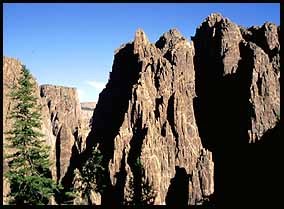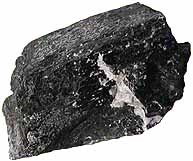
Schists are strongly foliated, and look like a stack of paper. Some of the best places to see schist are among the spires at Gunnison Point or Kneeling Camel View. The Great Pillars, seen here, are among the largest examples of schist in the canyon. The main difference between schist and gneiss is the thickness of their internal layers, known as lamellae (pronounced "la MEL lee"). Gneiss has thick lamellae and schist have very thin, fine layers. There are two kinds of schists found in the canyon, either a mica-rich schist, that has a lot of biotite and muscovite mica, or a schist rich in hornblende, a type of mineral called amphibole. A zone of schist crosses the canyon between Gunnison Point and Pulpit Rock Overlook. Rare minerals such as garnets, sillimanite, staurolite or andalusite can be common in places. Plagioclase

Hornblende
|
Last updated: February 24, 2015
